Birdfinding.info ⇒ Probably the most ubiquitous bird species. Its scientific name, Passer domesticus, literally means “house bird,” and true to that name it can be found in the vast majority of human settlements except in the one significant gap in its global distribution, which extends from East Asia though Indonesia to western Australia.
House Sparrow
Passer domesticus
Family: Passeridae
Native to Eurasia and northern Africa; introduced elsewhere nearly worldwide. Lives in close association with humanity in cities, towns, and farmland. Across much of its range it rarely strays far from buildings. Though it can also survive in some natural environments, it is more remarkable for its capacity to adapt to the built environment. It often enters large buildings, such as warehouses and industrial sites including mines—in at least one case, nesting successfully 640 m underground in a coalmine in Yorkshire, England.
Occurs nearly throughout Europe except for the areas occupied by Italian Sparrow—i.e., peninsular Italy, Sicily, Corsica, and Crete—east across most of Asia except the Far East—absent from Manchuria, the Korean Peninsula, adjacent southeastern Russia, Japan, Taiwan, Hainan, most of China (though there are several localized populations in western and central provinces), and the southern Malay Peninsula (except Singapore). Also absent from the Philippines and Indonesia. Otherwise resident at least locally almost worldwide apart from extensive forests and inhospitably barren, arid, and frigid zones.
Present in all regions of Africa. Native mainly north of the Sahara from Morocco east to Egypt, and south through the Nile Valley and along the Red Sea to central Sudan and northern Eritrea. Introduced and spreading across much of West Africa, the Sahel, and most of eastern and southern Africa from coastal Congo (Brazzaville), the southern D.R. Congo, South Sudan, southern Ethiopia, and southern Somalia south to Cape Town.

North American Breeding Bird Survey Abundance Map. U.S. Geological Survey 2015

Brazilian records from © WikiAves
Introduced populations also well-established nearly throughout the Americas, eastern Australia, New Guinea, and on most island groups of the Pacific, Indian, and Atlantic Oceans.
In the Americas, it was originally introduced to New York City and has since spread throughout North America and most of Middle America and the West Indies (but mostly absent from a few areas such as the Yucatán Peninsula and some of the Lesser Antilles). In South America, it is well-established nearly throughout, except that it is mostly absent from Colombia, and only locally established in a few areas north of the Amazon Basin, mainly in the north-coastal lowlands from the Guajira Peninsula to Anzoátegui, and in the Guianas.
In Australia, it is established nearly throughout the eastern half, west to central Queensland and central South Australia, locally farther west and north, and locally in a few urban areas of New Guinea.
Identification
One of the world’s most familiar birds: the generic sparrow.
Breeding male is readily recognized by its distinctive head pattern: gray crown with chestnut border and nape, whitish cheeks, and black mask, beard, and bib. The breeding male’s bill is usually all-black.
The wings, mantle, and tail are streaked medium-brown-and-black. Typically has a single bold whitish wingbar, although it is not always visible.
The underparts, back, and rump—i.e., most of the body plumage except the mantle—are pale-gray.

House Sparrow, breeding male, showing bold whitish wingbar. (Ronda, Málaga, Andalucía, Spain; May 24, 2020.) © Santiago Caballero Carrera

House Sparrow, breeding male, showing bold whitish wingbar. (Ponnani Beach, Malappuram, Kerala, India; May 3, 2018.) © Mathew Thekkethala

House Sparrow, breeding male with wingbar concealed. (Milton, Massachusetts; April 16, 2015.) © Evan Lipton
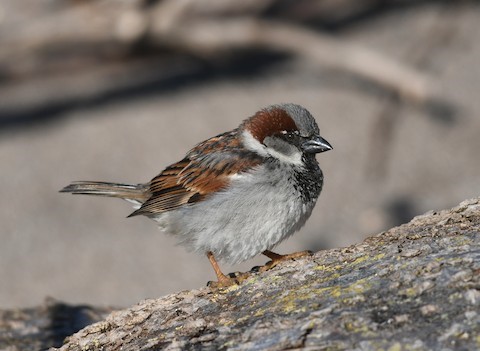
House Sparrow, breeding male with unusually dark-gray cheeks. (Point Pelee National Park, Ontario; April 27, 2019.) © Joshua D. Vandermeulen

House Sparrow, breeding male with prey. (Sedona, Arizona; April 26, 2017.) © Eric Gofreed

House Sparrow, breeding male. (Gazelle Valley, Yerushalayim, Israel; May 29, 2020.) © Shachar Hizkiya

House Sparrow, breeding male with brown mottling in its black bib. (Yolo Bypass Wildlife Area, West Sacramento, California; April 12, 2015.) © Matt Davis

House Sparrow, breeding male. (Ronda, Málaga, Andalucía, Spain; April 10, 2020.) © Santiago Caballero Carrera
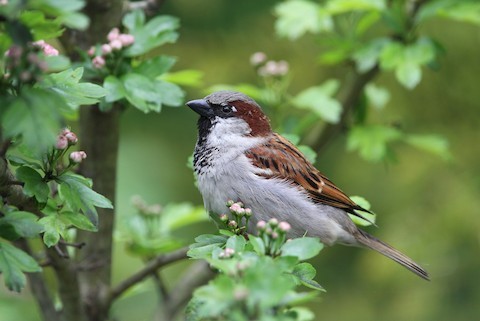
House Sparrow, breeding male. (Spechtweg, Bayern, Germany; May 21, 2010.) © Christoph Moning
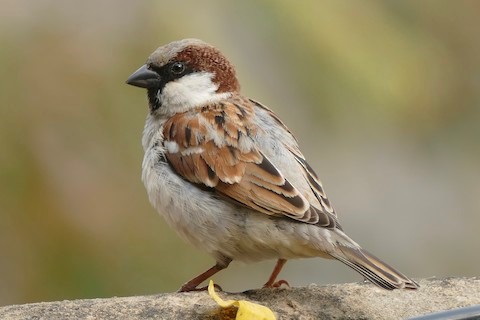
House Sparrow, breeding male, showing extensively gray body plumage, with brown-and-black streaking limited to wings and mantle. (Neemrana, Rajasthan, India; February 22, 2020.) © Peter Kaestner

House Sparrow, breeding male, showing bold whitish wingbar. (Sedona, Arizona; April 26, 2017.) © Eric Gofreed

House Sparrow, breeding male, showing bold whitish wingbar. (Bowling Green Marsh RSPB Reserve, Devon, England; February 24, 2017.) © Thomas Gibson

House Sparrow, breeding male with full black bib. (Cannon Beach, Oregon; June 20, 2020.) © Mason Maron
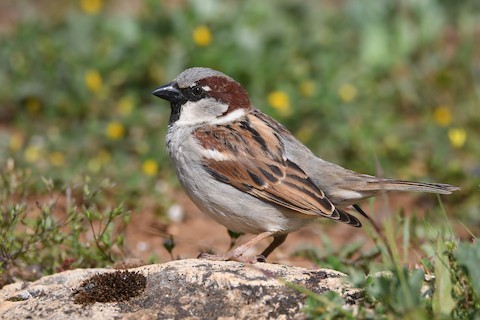
House Sparrow, breeding male. (Ronda, Málaga, Andalucía, Spain; April 10, 2020.) © Santiago Caballero Carrera

House Sparrow, breeding male. (Rotary Marsh, Kelowna, British Columbia; March 31, 2019.) © Nick Swan
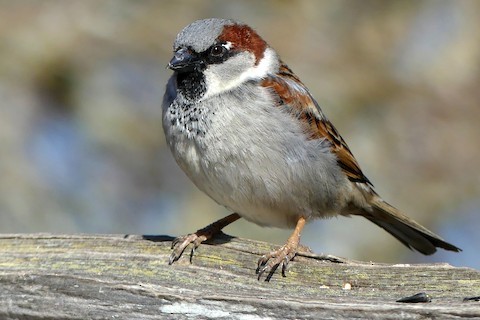
House Sparrow, breeding male. (Reifel Bird Sanctuary, Richmond, British Columbia; March 17, 2019.) © Brad Vissia
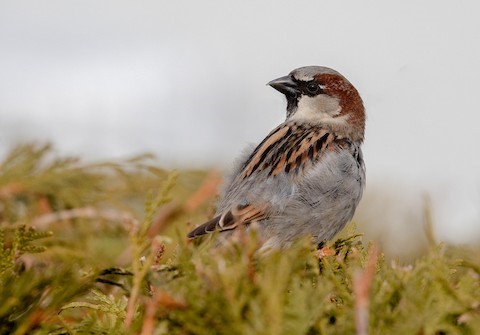
House Sparrow, breeding male. (Noyan, Le Haut-Richelieu, Quebec; March 14, 2019.) © Suzanne Labbé
Nonbreeding male is similar to breeding male, but duller, less crisply patterned. Its bill is often yellow or yellowish-orange, at least partly.
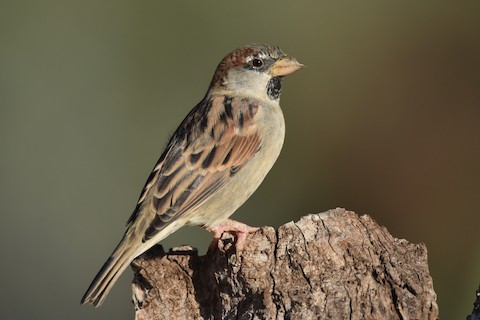
House Sparrow, nonbreeding male with mostly yellow bill. (Ronda, Málaga, Andalucía, Spain; October 10, 2019.) © Santiago Caballero Carrera

House Sparrow, nonbreeding male with mostly yellow bill. (Uthörn, List, Germany; August 15, 2007.) © Christoph Moning
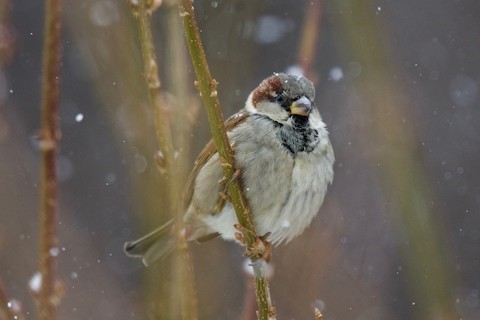
House Sparrow, nonbreeding male. (Awbury Arboretum, Philadelphia, Pennsylvania; January 7, 2017.) © Scott Fraser
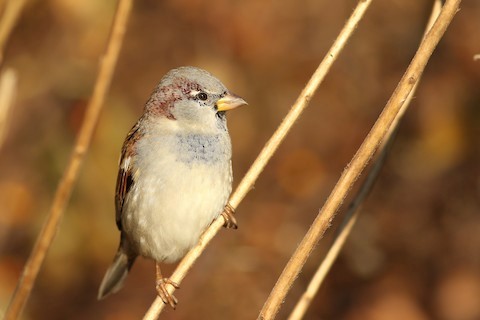
House Sparrow, nonbreeding male. (Broad Cove, Somerset, Massachusetts; November 15, 2019.) © Matthew Eckerson
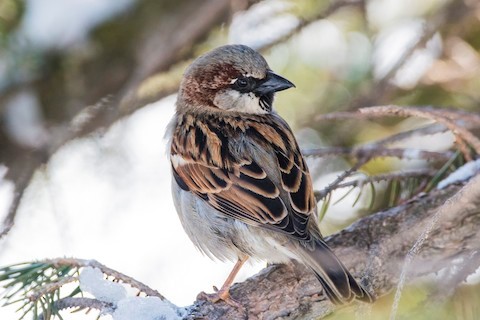
House Sparrow, nonbreeding male. (Terra losa, Edmonton, Alberta; April 21, 2017.) © Andrew Whitham

House Sparrow, nonbreeding male with mostly yellow bill. (Marshlands Conservancy, Rye, New York; December 27, 2019.) © Alex Wiebe
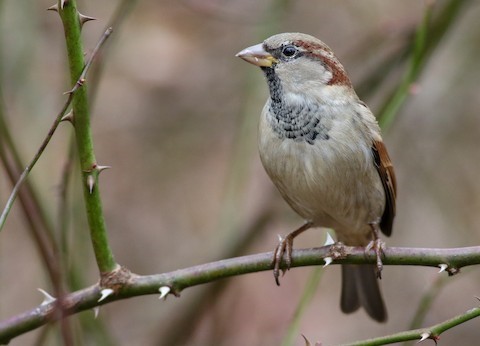
House Sparrow, nonbreeding male with mostly yellow bill. (Marshlands Conservancy, Rye, New York; December 27, 2019.) © Alex Wiebe
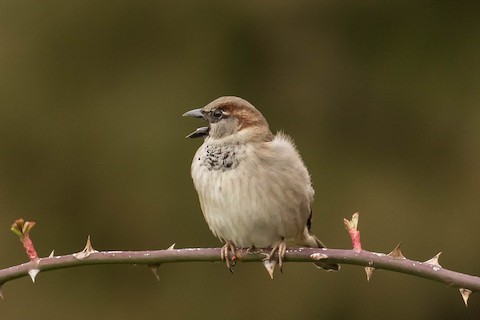
House Sparrow, nonbreeding male. (Western Gateway Regional Park, Penn Valley, California; March 7, 2017.) © Patricia Clark

House Sparrow, nonbreeding male. (Neah Bay, Washington; January 15, 2017.) © John F. Catchet

House Sparrow, nonbreeding male. (Gharana, Ranbir Singh Pura, Jammu, India; November 18, 2019.) © Pankaj Chibber
Females and immatures are drab and somewhat nondescript—and resemble females and immatures of a few closely related species (see below).
They are predominantly buffy-to-grayish overall with brown and blackish streaked wings, mantle, and tai, and a mostly pale yellowish, pinkish, or horn-colored bill.
Their most noticeable feature is a buffy or whitish eyebrow stripe and a darker eyeline that extend back together then turn downward toward the nape.
The eyebrow stripe is typically buffy on females and more whitish on immatures (at least in some cases). Immature males also tend to have at least some black on the bill.

House Sparrow, female or immature. (Spechtweg, Bayern, Germany; May 21, 2010.) © Christoph Moning

House Sparrow, female. (Belle Isle, Michigan; October 6, 2019.) © Andrew Simon
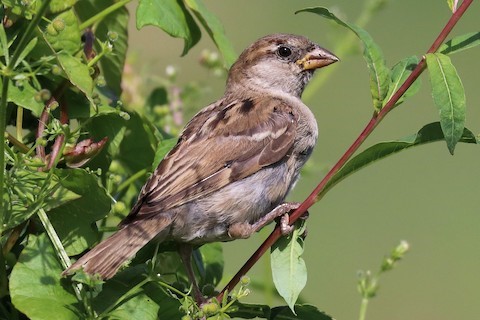
House Sparrow, female. (Loans, South Ayrshire, Scotland; July 25, 2018.) © Bruce Kerr
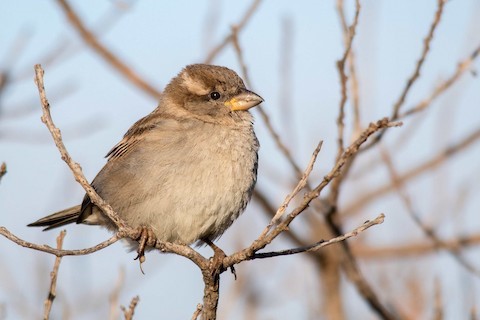
House Sparrow, female showing exceptionally pronounced pale eyebrow stripe behind the eye. (Jawbone Flora and Fauna Reserve, Hobsons Bay, Victoria, Australia; September 16, 2018.) © Andrew Allen
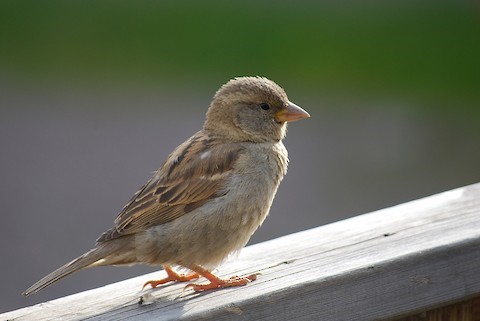
House Sparrow, female. (Abisko Tourist Station, Norrbottens Län, Sweden; July 25, 2010.) © Ruud Visser

House Sparrow, female with male in background. (Uthörn, List, Germany; August 15, 2007.) © Christoph Moning

House Sparrow, female. (Heligoland, Schleswig-Holstein, Germany; October 8, 2019.) © Volker Hesse

House Sparrow, female showing entirely pale-gray underparts. (Punta Gorda, Belize; October 6, 2019.) © Jorge Eduardo Ruano

House Sparrow, female or immature. (Spechtweg, Bayern, Germany; May 21, 2010.) © Christoph Moning

House Sparrow, immature. (Andrews University, Berrien Springs, Michigan; April 20, 2016.) © Adam Jackson

House Sparrow, immature—note mostly blackish bill and whitish eyebrow. (Ronda, Málaga, Andalucía, Spain; April 10, 2020.) © Santiago Caballero Carrera
Cf. Sind Sparrow. In western India and adjacent Pakistan, the House and Sind Sparrows occur together and are easily confused. The main differences between the males are Sind’s less extensive chestnut on nape and its gray, bib-less chest.
Females and immatures of the two species seem to be identical—or so similar that the variation within House Sparrows swamps any potentially noticeable difference between the species.
Cf. Italian Sparrow. House and Italian Sparrows were traditionally regarded as conspecific—or more accurately, Italian Sparrow was regarded as a hybrid of House and Spanish Sparrows. Males are readily distinguished by the color of the crown: gray on House versus all-chestnut on Italian. Females and immatures appear to be indistinguishable, or nearly so, although Italian tends to show faint streaking on the underparts.
Cf. Other Female and Immature Passers. Female and immature House Sparrow strongly resemble females and/or immatures of the following, mostly localized species: Spanish, Cinnamon, Iago, Dead Sea, Somali, and Chestnut Sparrows. In each case, the other species can be identified based on close study of the head patterns and streaking, but the differences are often subtle details.
Notes
Polytypic species consisting of twelve recognized subspecies.
References
Alderfer, J., and J.L. Dunn. 2014. National Geographic Complete Birds of North America (Second Edition). National Geographic Society, Washington, D.C.
BirdLife International. 2019. Passer domesticus (amended version of 2018 assessment). The IUCN Red List of Threatened Species 2019: e.T103818789A155522130. https://dx.doi.org/10.2305/IUCN.UK.2018-2.RLTS.T103818789A155522130.en. (Accessed October 3, 2020.)
Brazil, M. 2009. Birds of East Asia. Princeton University Press, Princeton, N.J.
Clement, P., A. Harris, and J. Davis. 1993. Finches and Sparrows: An Identification Guide. Princeton University Press.
eBird. 2020. eBird: An online database of bird distribution and abundance. Cornell Lab of Ornithology, Ithaca, N.Y. http://www.ebird.org. (Accessed October 3, 2020.)
Hollom, P.A.D., R.F. Porter, S. Christensen, and I. Willis. 1988. Birds of the Middle East and North Africa. T & AD Poyser, Calton, England.
Kirwan, G.M., A. Levesque, M. Oberle, and C.J. Sharpe. 2019. Birds of the West Indies. Lynx Edicions, Barcelona.
Mullarney, K., L. Svensson, D. Zetterström, and P.J. Grant. 1999. Birds of Europe. Princeton University Press.
Pratt, H.D., P.L. Bruner, and D.G. Berrett. 1987. A Field Guide to the Birds of Hawaii and the Tropical Pacific. Princeton University Press.
Pyle, R.L., and P. Pyle. 2017. The Birds of the Hawaiian Islands: Occurrence, History, Distribution, and Status. Version 2 (January 1, 2017). http://hbs.bishopmuseum.org/birds/rlp-monograph/. B.P. Bishop Museum, Honolulu, Hawaii.
Raffaele, H., J. Wiley, O. Garrido, A. Keith, and J. Raffaele. 1998. A Guide to the Birds of the West Indies. Princeton University Press.
Ridgely, R.S., and G. Tudor. 1989. The Birds of South America, Volume I: The Oscine Passerines. University of Texas Press.
Robson, C. 2002. Birds of Thailand. Princeton University Press.
Schulenberg, T.S., D.F. Stotz, D.F. Lane, J.P. O’Neill, and T.A. Parker. 2007. Birds of Peru. Princeton University Press.
Sibley, D.A. 2000. The Sibley Guide to Birds. Alfred A. Knopf. New York.
Sinclair, I., P. Hockey, W. Tarboton, and P. Ryan. 2011. Birds of Southern Africa (Fourth Edition). Random House Struik (Pty) Ltd. Cape Town, South Africa.
van Perlo, B. 1999. Birds of Southern Africa. Princeton University Press.
van Perlo, B. 2002. Birds of Western and Central Africa. Princeton University Press.
Xeno-Canto. 2020. House Sparrow – Passer domesticus. https://www.xeno-canto.org/species/Passer-domesticus. (Accessed October 3, 2020.)
Wikiaves. 2020. Pardal, https://www.wikiaves.com.br/wiki/pardal. (Accessed October 3, 2020.)

